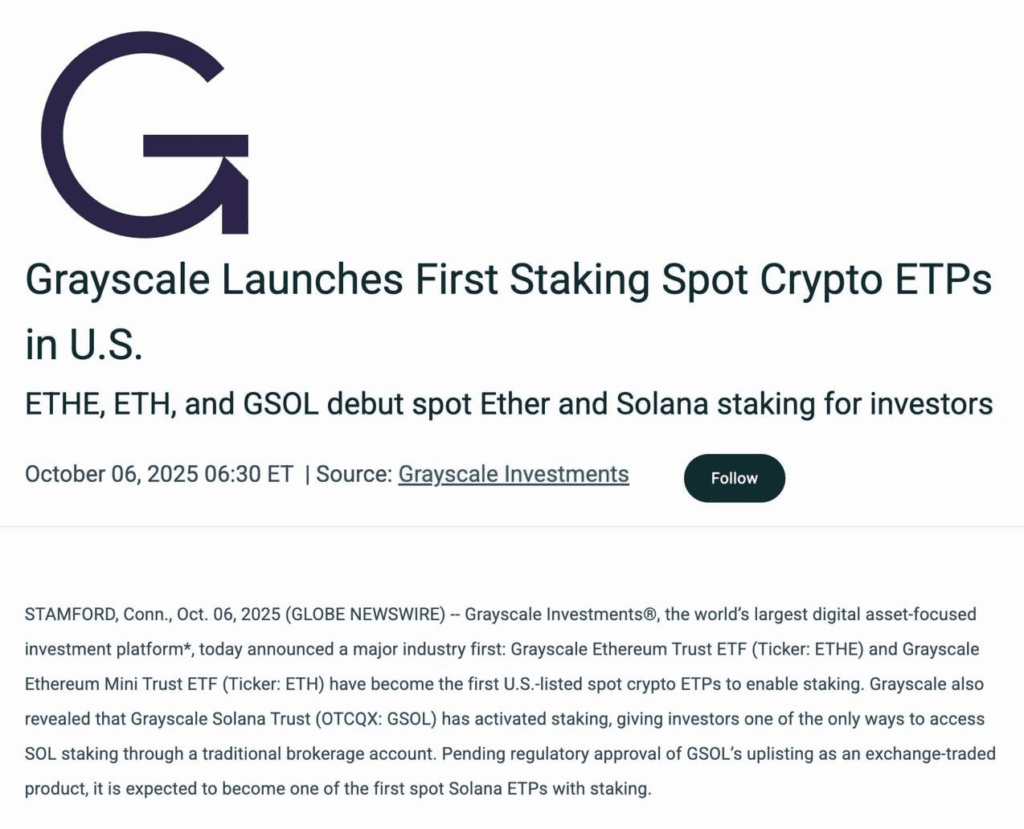
Grayscale Investments, one of the world’s largest crypto asset managers, has announced the launch of the first U.S. spot ETFs for Ethereum (ETHE) and Solana (GSOL) with support for staking. This event has become historic — for the first time, American investors will be able to earn income from participating in ETH and SOL networks directly through exchange-traded funds, without engaging in crypto operations on their own.
A breakthrough at the junction of crypto and traditional investments
The emergence of ETFs with the possibility of staking is a step that many market participants have been waiting for. Until now, crypto funds in the United States have provided only passive ownership of the asset, without the possibility of participating in online rewards.
Now Grayscale combines two models: exchange-traded fund and profitable staking, turning ownership of cryptocurrencies into a tool similar to classic dividend assets.
Both platforms — Ethereum and Solana — have long proven their technological viability. Ethereum remains the largest ecosystem for smart contracts and DeFi, while Solana demonstrates high throughput and active development of NFT and GameFi projects. The addition of staking makes investments in these networks even more attractive.
How it will work
The new ETFs provide investors with the opportunity to own ETH and SOL tokens through familiar brokerage accounts. At the same time, assets within the funds participate in staking, and the rewards received are automatically reflected in their value.
That is, the investor does not need to do anything — the income from staking is “embedded” in the fund itself. The management company will use a network of reliable institutional validators to maintain security and profitability stability.
In addition, Grayscale has implemented a “Liquidity Sleeve” mechanism — some assets always remain in liquid form, so that, if necessary, repurchase requests can be executed without delays associated with the release period in the Ethereum blockchain.

Why did Grayscale take this step?
According to the company’s representatives, the launch of staking ETFs is a logical continuation of the strategy for developing the market of real profitable crypto tools.
Grayscale is betting that institutional investors want to receive not only exposure to digital assets, but also stable returns. In this case, staking acts as an analogue of interest income or dividends, which brings crypto assets closer to the usual stock market models.
In addition, the company is seeking to regain its leadership amid increasing competition from giants such as BlackRock and Fidelity, which are also preparing their own crypto ETFs.
Possible market impact
- Growing interest in ETH and SOL. The new investment format can lead to significant capital inflows into both networks, as access to staking is now becoming as simple and regulated as possible.
- Institutionalization of the crypt. Thanks to staking-enabled ETFs, cryptocurrencies are taking another step towards full adoption within the traditional financial system.
- Increased demand for staking assets. If the Grayscale product shows steady profitability, similar solutions may appear for other networks — Cardano, Avalanche, Polkadot, etc.
- Regulatory implications. The SEC had previously been cautious about the idea of including staking in ETFs, but the approval of this product indicates a gradual softening of the regulators’ position. This may pave the way for new initiatives in the market.
- Risks for investors. Despite all the advantages, there remain risks associated with technical failures, price volatility for ETH and SOL, as well as possible sanctions against validators (slashing). In addition, a portion of the remuneration may be withheld to cover the fund’s fees.
Why is this a historic event?
Launching an ETF with staking is not just a technical function. This is a sign that the crypto industry is maturing. Previously, investors bought tokens directly through exchanges, now they can participate in the Ethereum and Solana ecosystems through classic investment tools — safely, transparently and within the framework of current regulation.
Grayscale is making the first move, but other players will undoubtedly follow. In the coming months, the market may see a real boom in staking-enabled products, and the United States will finally establish itself as the center of institutional crypto investment.
Result
The launch of spot ETFs on Ethereum and Solana with staking is one of the most significant events of 2025 for the crypto economy. Grayscale has not only created new products, it has actually opened the way to connect two worlds: decentralized technologies and traditional equity capital.
If the idea is successful, in a few years, staking ETFs may become as familiar a tool as stock indexes or commodity ETFs. And then crypto assets will finally cease to be an “alternative” class, becoming a full—fledged element of the global financial market.
Sources:
- Grayscale — Launches First U.S. Spot Ethereum and Solana ETFs with Staking Functionality
- Bankless Times — Grayscale introduces staking-enabled crypto ETFs for U.S. investors
- CryptoBriefing — Grayscale launches first staking spot ETFs in the United States
- Bloomberg Crypto — Ethereum and Solana ETFs to include staking rewards mechanism


